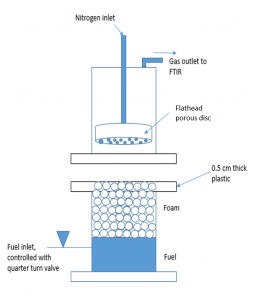Measuring Fuel Transport through Fluorocarbon and Fluorine-free Firefighting Foams
K. Hinnant et al., presented at the 12th International Symposium for Fire Safety Science, Fire Safety Journal, 2017, 91, 653-661
 Abstract: A flux chamber was designed to measure the transient fuel transport through a foam layer before significant degradation of foam occurred. The fuel transport rate through AFFF (fluorinated foam) was much slower than through RF6 (fluorine-free foam) with break-through times being 820 s and 276 s respectively over n-heptane. The fuel flux through AFFF covering three fuel pools (n-heptane, iso-octane, and methyl-cyclohexane) was also measured. AFFF had the smallest flux over iso-octane with a break-through time over 1900 s and the highest flux over methyl-cyclohexane with a break-through time under 80 s even though the fuels have similar vapor pressures at room temperature. Despite the lack of aqueous film formation on an iso-octane fuel pool, the fuel vapor flux through AFFF was much smaller relative to the methyl-cyclohexane pool, which enables film formation due to its higher surface tension than iso-octane. Our measurements of transient fuel flux show that the foam layer is a significant barrier to fuel vapor transport. The data suggest a transient mechanism based on the suppression of fuel adsorption onto bubble lamellae surfaces due to the oleophobicity of fluorocarbon surfactants, which is consistent with fuel solubility data. This suggests that surfactants that suppress fuel adsorption and solubility into bubble lamellae surfaces may reduce fuel transport through foams.
Abstract: A flux chamber was designed to measure the transient fuel transport through a foam layer before significant degradation of foam occurred. The fuel transport rate through AFFF (fluorinated foam) was much slower than through RF6 (fluorine-free foam) with break-through times being 820 s and 276 s respectively over n-heptane. The fuel flux through AFFF covering three fuel pools (n-heptane, iso-octane, and methyl-cyclohexane) was also measured. AFFF had the smallest flux over iso-octane with a break-through time over 1900 s and the highest flux over methyl-cyclohexane with a break-through time under 80 s even though the fuels have similar vapor pressures at room temperature. Despite the lack of aqueous film formation on an iso-octane fuel pool, the fuel vapor flux through AFFF was much smaller relative to the methyl-cyclohexane pool, which enables film formation due to its higher surface tension than iso-octane. Our measurements of transient fuel flux show that the foam layer is a significant barrier to fuel vapor transport. The data suggest a transient mechanism based on the suppression of fuel adsorption onto bubble lamellae surfaces due to the oleophobicity of fluorocarbon surfactants, which is consistent with fuel solubility data. This suggests that surfactants that suppress fuel adsorption and solubility into bubble lamellae surfaces may reduce fuel transport through foams.
